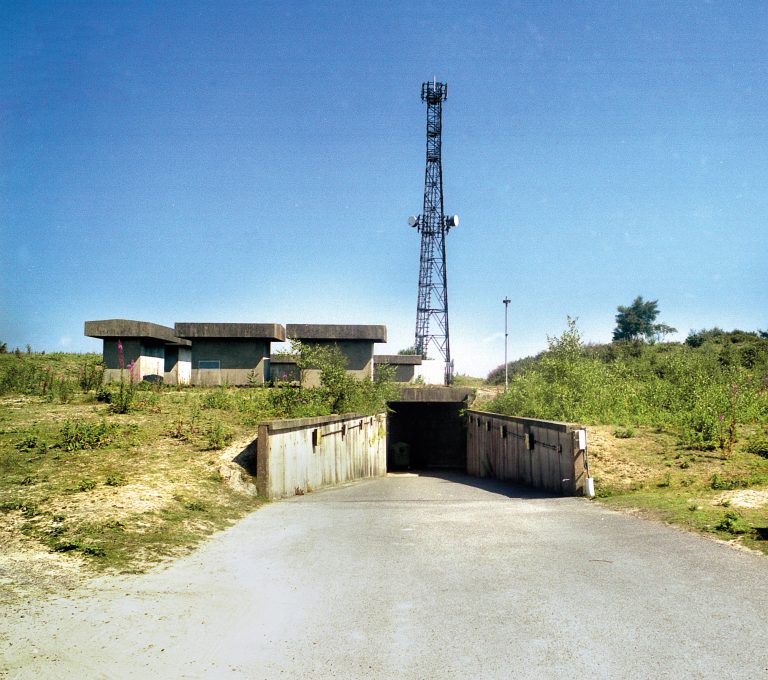Aspidistra: The wartime breakthrough you’ve never heard of
8 August 2019
On 16 May 1941 the Prime Minister, Winston Churchill, heard about a new, powerful weapon. Immediately seeing its potential, he encouraged its development. He knew this weapon could cause huge damage and yet it did not use bullets or explosions; it used words.
The weapon was so-called “Black Propaganda” – creating enemy propaganda that Germans would think was German. This type of propaganda is very believable and therefore is more likely to convince the enemy. The easiest way of delivering these messages was radio, but there was a problem. The radio signal needed to be strong enough to convince listeners that it was being transmitted from Germany. To create such a strong signal, the radio transmitter had to be incredibly powerful.
Building a revolutionary transmitter
The task of finding such a radio transmitter fell to the Special Communication Unit VIII, a predecessor of FCDO Services. Harold K Robin, the chief engineer, had the job of making the weapon a reality.
It so happened that the Radio Corporation of America (RCA) had created two high powered radio transmitters. However, a change in the law meant they could not be used in the USA, so the RCA were eager to sell them to Britain. Harold saw their potential, and travelled to America to work with the RCA to improve the radio transmitters.
These improvements made the transmitters unique. Originally consisting of two 200 KW transmitters, Harold and the RCA developed them to become a single transmitter, with 600 KW. To put it in perspective, most transmitters at the time were 25-150 KW, and the new transmitter could be “split” into multiple smaller units. This made it the most powerful medium wave radio transmitter in the world at the time.
The thing that made the transmitter really impressive, however, was how easy it was to tune. Back then it usually took several hours to change the frequency of a transmitter, as technicians had to rearrange crystals. Harold made it able to move frequency in a fraction of a second, the same way you change channels on a car radio. This meant it could do more, and it was harder for the Germans to stop it.
Perfecting the transmitter wasn’t the end of Harold’s work. Transporting them meant sailing across the U-boat infested Atlantic Ocean. And whilst the transmitter arrived safely, the ship carrying the aerial was torpedoed and the aerial had to be rebuilt.
Harold did have some luck when the Canadian government generously loaned a team of Canadian engineers nearby, to help construct the site at Crowborough.
A ‘very good job of propaganda’

The improved transmitters were named Aspidistra, referencing the popular Gracie Fields song ‘The Biggest Aspidistra in the World’. Aspidistras used to be popular house plants that were fairly short, but the song describes how one grows until it ‘nearly reached the sky’.
The British used Aspidistra during the Second World War for several operations. It would take several articles to do justice to them all, but two of the most important were Soldatensender Calais and Operation Dartboard.
Soldatensender Calais
Soldatensender Calais pretended to be a radio station for German soldiers, broadcasting jazz music interspersed with news bulletins. Information from spy networks kept the news as accurate as possible, so that listeners trusted the station. However, all news was presented as negatively as possible to destroy the morale of the listeners.
This station was so successful, it received high praise from the master of propaganda himself: Joseph Goebbels.
In the evening the so-called “Soldatensender Calais” which evidently originates in England and uses the same wavelengths at Radio Deutschland – when the latter is out during air raids – gave us something to worry about. The station does a very good job of propaganda, and from what is put on the air one can gather that the English know exactly what they have destroyed in Berlin and what they have not.
28 November 1943, Dr Joseph Goebbels [1]
Operation Dartboard
Because Aspidistra could change frequency quickly, it could impersonate German ground control. Fluent German speakers gave false information to German pilots, redirecting them away from Allied bomber attacks. Every time the Germans tried to make ground control harder to impersonate, the British adapted. For example, when German ground control started using female controllers, the British followed suit.
Not grabbing the headlines, the role of Aspidistra is mostly forgotten. Yet it caused disruption and confusion across Germany, and was a marvel of engineering.
After the War
At the end of the Second World War, the BBC took control of Aspidistra. It was clear that Aspidistra was the perfect transmitter for the new BBC World Service. It could reach far across Europe, and its ability to change frequencies meant it could deliver local programs in different countries.
The predecessors of FCDO Services continued to maintain Aspidistra, supplying the technology, staff and locations for the BBC World Service to broadcast around the world. Finally, in 1984, the Government gave the funding for the World Service directly to the BBC, and they became responsible for maintaining their aerials worldwide.
The site in Crowborough still exists but today Sussex police use it for training purposes. FCDO Services is stronger than ever, and while they have evolved into producing security services, to this day they still develop cutting edge technology.
[1] Joseph Goebbels, The Goebbels Diaries: 1942-1943. trans. Louis P. Lochner (Garden City: Doubleday, 1948)
